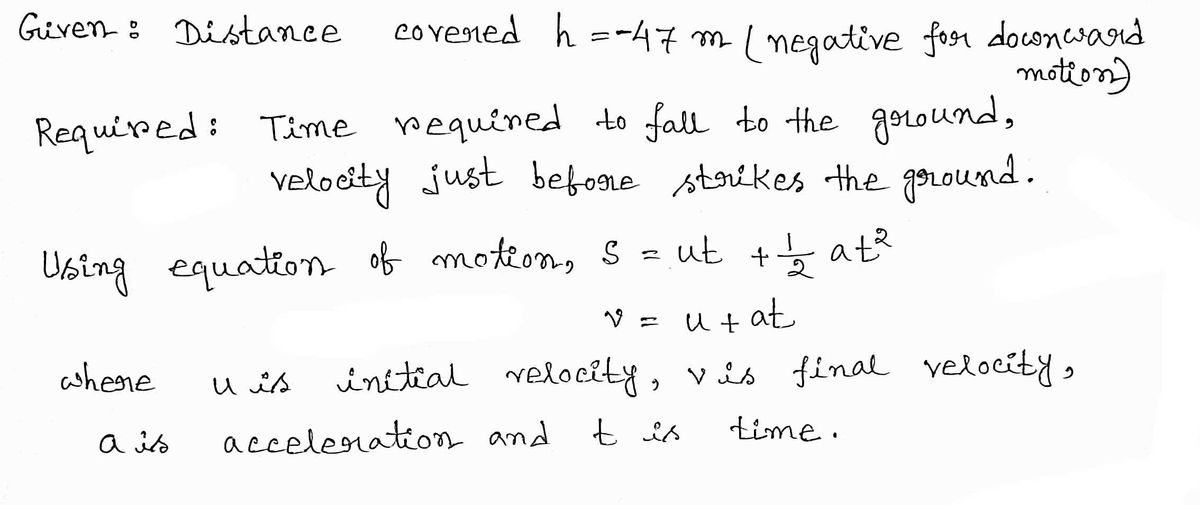I just need the practice problem solved with work shown. The rest of the images provides the information needed to solve the problem. The correct answer is also provided to check work
I just need the practice problem solved with work shown. The rest of the images provides the information needed to solve the problem. The correct answer is also provided to check work
College Physics
1st Edition
ISBN:9781938168000
Author:Paul Peter Urone, Roger Hinrichs
Publisher:Paul Peter Urone, Roger Hinrichs
Chapter2: Kinematics
Section: Chapter Questions
Problem 33PE: An unwary football player collides with a padded goalpost while running at a velocity of 7.50 m/s...
Related questions
Question
I just need the practice problem solved with work shown. The rest of the images provides the information needed to solve the problem. The correct answer is also provided to check work.

Transcribed Image Text:EXAMPLE 2.10 Falling euro in Pisa
Our first example of free-fall motion is very simple. A 2-euro coin is dropped from the Leaning Tower of
Pisa. It starts from rest and falls freely. Ignore the effects of air resistance, and compute its position and
velocity after 1.00 s, 2.00 s, and 3.00 s.

Transcribed Image Text:SOLUTION
SET UP Figure 2.25 shows the diagram we sketch. For a coordinate
system, we choose a vertical axis with the upward direction to be posi-
tive, and we place the origin at the starting point. The position, velocity,
and acceleration have only y components. The initial value yo of the co-
ordinate y and the initial y component of velocity voy are both zero. The
acceleration is downward (in the negative y direction), so the constant
y component of acceleration is ay = -g = -9.80 m/s². (Remember
that, by definition, g itself is always positive.)
SOLVE From Equations 2.13 and 2.12 we have
y = vot + a₂t² = 0 + (−8)t² = (-4.90 m/s²)t²,
SW BOULU05 DIN 100 mort,
+ ayt = 0 + (−g)t = (-9.80 m/s²)t.
Vy
= Voy
og
Amoer - Yel
(alm
2
s, y₁
Using subscript 1 for the first time, we find that when
t = t₁ = 1.00
1.00 s, y₁ = (-4.90 m/s²) (1.00 s)² = -4.90 m and v₁y =
Uly
(-9.80 m/s2)(1.00 s) = -9.80 m/s. The coin is therefore 4.90 m be-
low the origin (because y is negative) and has a downward velocity (uy
is negative) with magnitude 9.80 m/s.
ob
The positions and velocities at 2.00 s and 3.00 s are found in the
same way. The results are -19.6 m and -19.6 m/s at t = 2.00 s and
-44.1 m and -29.4 m/s at t = 3.00 s.
REFLECT All our values of y and v, are negative because we have cho-
sen the positive y axis to be upward. We could just as well have chosen
the downward direction to be positive. In that case, the y component of
acceleration would have been a, = g = +9.80 m/s². The crucial point
+9.80 m/s². The crucial
that you must decide at the start which direction is positive, and then
stick with your decision.
mioq
dgu
point
vizu
odit soulsy ovings
zli tud Jmclzni as ch
at 0195 gr
play
The Leaning Tower
***
sty
din 2.6 Freely Falling Objects 49
CHON
ill
LATION
B
1435
al
FIGURE 2.25
Our sketch for the problem
eft im
Y = 0
Y
0
V₁y = ?
Vzy=?
V3Y
=?
to = 0, yo=0
t₁ = 100 s, y₁= ?
ay=-9--980 m/s²
t₂ = 2.00 s₂ Y₂ = ?
-
13=3.00 S, y3 = ?
Practice Problem: The coin is released 47.0 m above the ground.
How much time is required for the coin to fall to the ground? What
is its velocity just before it strikes the ground? Answers: 3.10 s,
-30.4 m/s.
how of snuf ow ob anoires 18// 39303
Expert Solution
Step 1

Step by step
Solved in 2 steps with 2 images

Knowledge Booster
Learn more about
Need a deep-dive on the concept behind this application? Look no further. Learn more about this topic, physics and related others by exploring similar questions and additional content below.Recommended textbooks for you

College Physics
Physics
ISBN:
9781938168000
Author:
Paul Peter Urone, Roger Hinrichs
Publisher:
OpenStax College

Principles of Physics: A Calculus-Based Text
Physics
ISBN:
9781133104261
Author:
Raymond A. Serway, John W. Jewett
Publisher:
Cengage Learning

Physics for Scientists and Engineers with Modern …
Physics
ISBN:
9781337553292
Author:
Raymond A. Serway, John W. Jewett
Publisher:
Cengage Learning

College Physics
Physics
ISBN:
9781938168000
Author:
Paul Peter Urone, Roger Hinrichs
Publisher:
OpenStax College

Principles of Physics: A Calculus-Based Text
Physics
ISBN:
9781133104261
Author:
Raymond A. Serway, John W. Jewett
Publisher:
Cengage Learning

Physics for Scientists and Engineers with Modern …
Physics
ISBN:
9781337553292
Author:
Raymond A. Serway, John W. Jewett
Publisher:
Cengage Learning

Physics for Scientists and Engineers: Foundations…
Physics
ISBN:
9781133939146
Author:
Katz, Debora M.
Publisher:
Cengage Learning

University Physics Volume 1
Physics
ISBN:
9781938168277
Author:
William Moebs, Samuel J. Ling, Jeff Sanny
Publisher:
OpenStax - Rice University

Glencoe Physics: Principles and Problems, Student…
Physics
ISBN:
9780078807213
Author:
Paul W. Zitzewitz
Publisher:
Glencoe/McGraw-Hill